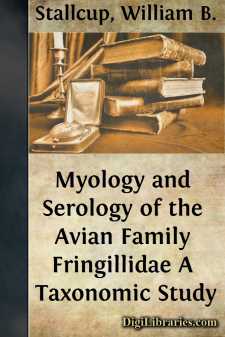Categories
- Antiques & Collectibles 13
- Architecture 36
- Art 48
- Bibles 22
- Biography & Autobiography 813
- Body, Mind & Spirit 142
- Business & Economics 28
- Children's Books 15
- Children's Fiction 12
- Computers 4
- Cooking 94
- Crafts & Hobbies 4
- Drama 346
- Education 46
- Family & Relationships 57
- Fiction 11828
- Games 19
- Gardening 17
- Health & Fitness 34
- History 1377
- House & Home 1
- Humor 147
- Juvenile Fiction 1873
- Juvenile Nonfiction 202
- Language Arts & Disciplines 88
- Law 16
- Literary Collections 686
- Literary Criticism 179
- Mathematics 13
- Medical 41
- Music 40
- Nature 179
- Non-Classifiable 1768
- Performing Arts 7
- Periodicals 1453
- Philosophy 64
- Photography 2
- Poetry 896
- Political Science 203
- Psychology 42
- Reference 154
- Religion 513
- Science 126
- Self-Help 84
- Social Science 81
- Sports & Recreation 34
- Study Aids 3
- Technology & Engineering 59
- Transportation 23
- Travel 463
- True Crime 29
Myology and Serology of the Avian Family Fringillidae A Taxonomic Study
Description:
Excerpt
IntroductionThe relationships of many groups of birds within the Order Passeriformes are poorly understood. Most ornithologists agree that some of the passerine families of current classifications are artificial groups. These artificial groupings are the result of early work which gave chief attention to readily adaptive external structures. The size and shape of the bill, for example, have been over-emphasized in the past as taxonomic characters. It is now recognized that the bill is a highly adaptive structure and that it frequently shows convergence and parallelism.
Since studies of external morphology have failed in some cases to provide a clear understanding of the relationships of passerine birds, it seems appropriate that attention be given to other morphological features, to physiological features, and to life history studies in an attempt to find other clues to relationships at the family and subfamily levels.
This paper reports the results of a study of the relationships of some birds of the Family Fringillidae and is based on the comparative myology of the pelvic appendage and on the comparative serology of saline-soluble proteins. Where necessary for comparative purposes, birds from other families have been included in these investigations.
It has long been recognized that the Fringillidae include dissimilar groups. Recent work by Beecher (1951b, 1953) on the musculature of the jaw and by Tordoff (1954) primarily on the structure of the bony palate has emphasized the artificial nature of the assemblage although these authors disagree regarding major divisions within it (see below).
The Fringillidae have been distinguished from other families of nine-primaried oscines by only one character—a heavy and conical bill (for crushing seeds). Bills of this form have been developed independently in several other, unrelated, groups; as Tordoff (1954:7) has pointed out, Molothrus of the Family Icteridae, Psittorostra of the Family Drepaniidae, and most members of the Family Ploceidae have bills as heavy and conical as those of the fringillids. The ploceids are distinguished from the fringillids by a single external character: a fairly well-developed tenth primary whereas in fringillids the tenth primary is absent or vestigial. Tordoff (1954:20) points out, however, that this distinction is of limited value since in other passerine families the tenth primary may be present in some species of a genus and absent in others. The Genus Vireo is an example. Furthermore, at least one ploceid (Philetairus) has a small, vestigial tenth primary, whereas some fringillids (Emberizoides, for example) possess a tenth primary which is rather large and ventrally placed (Chapin, 1917:253-254). Thus, it is obvious that studies based on other features are necessary in order to attain a better understanding of the relationships of the birds involved.
Sushkin's studies (1924, 1925) of the structure of the bony and horny palates have served as a basis for the division of the Fringillidae into as many as five subfamilies (Hellmayr, 1938:v): Richmondeninae, Geospizinae, Fringillinae, Carduelinae, and Emberizinae....


